Text
Something ive noticed about a lot of people who play dnd (myself included) is that… they arent really playing dnd.
I don’t mean that in the - they’ve homebrewed the system to the point where they are basically playing a completely different game. i mean it in the way that dnd is less of a game and more of a tool or frame work to tell improve stories with friends. Thats why so many tables have a significant amount of homebrew rules or play it loose with the rules - because dnd is secondary to the act of telling a story.
Unfortunately, dnd wasn’t built for such a narratively focused sandbox. It was built around dungeons and adventuring and violence in general - an aspect that is only a fraction of many stories that dnd is used to tell.
I think that is why so many people are resistant from trying other ttrpg systems that may give them a better player experience. They dont play dnd to play dnd but they dont even realize that. The game is secondary so why does it matter what game they play? Everyone at their table is already versed in dnd so they can make it work as a framework even if its trying to fit a square peg into a round hole.
This is something ive been thinking about a lot while making my ttrpg Tales from the Aether as I am inspecting my own view and experience with dnd and what i enjoy about it versus what could be done better. Why do me and my friends play dnd? To hang out and tell stories. Dnd happens to be the system i knew at the time we started and thus it is the one we used. But there is nothing particular about dnd that supports this goal while there are many things that hold us back - such as characters archetypes and classes being so ridged and having practically zero guidance for running the game outside of combat or adventuring. This is where homebrew comes in.
Ironically thats the entire premise of Tales from the Aether. I started making it years ago with the idea that this system is specifically a framework for people to tell improve stories with friends. That is the whole point. All of the mechanics revolve around giving players the tools to do what they want while the rules act more as a form of in universe world building (like a hard magic system) than actual rules.
The reason why so many people who play dnd are hesitant or straight up refuse to try out other ttrpgs is because the game is secondary. Its a tool. Its a framework that they can build off of to create the experience that they want. Its familiar so they know how to bend it, what parts to chip off or expand, to give them what they want. A new ttrpg, even if its one that gives them everything they want in a ttrpg, is unfamiliar and thus not worth investing in when they already have something that works well enough.
Idk i may be way off base here but from my own experience and from watching live plays and reading people’s takes on dnd and playing the game… thats kinda the conclusion ive come to.
297 notes
·
View notes
Text
It's free homebrew!

Outlaws of Thunder Junction comes out tomorrow, you know what that means?
It means, new Plane shift module made by me!
This one includes 6 backgrounds, a race and a subrace, 7 subclasses, and a and dozens of monsters. AND ITS FREE! That's right! From now on, all my brews will be 100% free.
Come get it all at my patreon! I also have a plane shift module for New Phyrexia, Eldraine, the Psio and Hemonomicon, and a whole bunch of other goodies!
47 notes
·
View notes
Text
I like how the THP on attack/grapple is worded so that it remains effective even if you already have THP. Maybe might need to be capped at a maximum? Then again, the THP gain is slow enough that if you're positive on thp you arent really being threatened to begin with.
Does the static AC benefit from holding a shield?
Aside from that, 10/10. All concerns addressed while retaining the aspects of the sub that were cool and even further expanded upon them. That's what we like to see.
Druidic Circle: Circle of Ruin
I just put out an update to my Circle of Ruin!
Ever wanted to play a stone based druid, or a druidic knight, well here's the subclass for you!
A front-line warrior druid that lets you make stone armour, grants martial weapon proficiencies, and just lets you grapple and pummel your enemies if you really want!
If you grab the PDF from the link above, you also get 'Lady Ethel of Scarwood' a CR6 NPC statblock with lore and tips on how to run in combat!
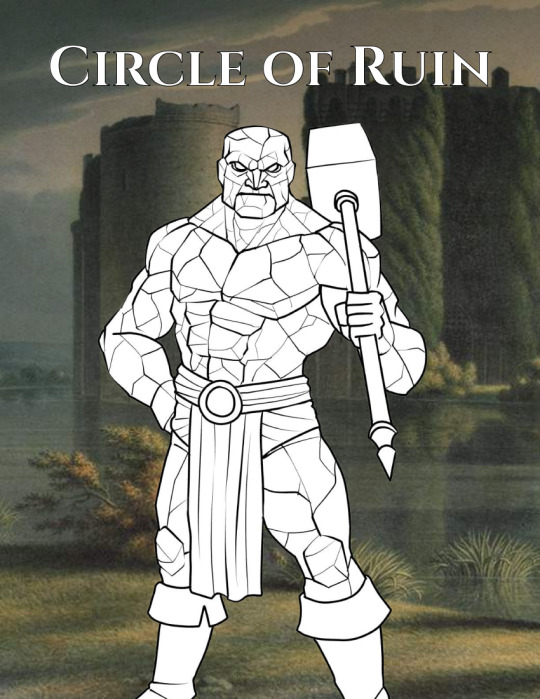

47 notes
·
View notes
Text
10/10. Retains the base idea and existing cool aspects of the sub while addressing all concerns, not introducing new issues, and expanding on the core of the subclass.
I like how the THP is specifically worded to make sure it stacks. Might want to put a cap on it? Then again, 10 minutes isn't long enough to reasonably make use of a bag of rats, and if you're going positive on THP you're not really threatened to begin with.
Does the static AC benefit from holding a shield?
Druidic Circle: Circle of Ruin
I just put out an update to my Circle of Ruin!
Ever wanted to play a stone based druid, or a druidic knight, well here's the subclass for you!
A front-line warrior druid that lets you make stone armour, grants martial weapon proficiencies, and just lets you grapple and pummel your enemies if you really want!
If you grab the PDF from the link above, you also get 'Lady Ethel of Scarwood' a CR6 NPC statblock with lore and tips on how to run in combat!


47 notes
·
View notes
Text
Interesting take on a martial Druid. Love the flavor. Always seemed weird that Spores Druid tried to encourage you to get into melee but didnt give Extra Attack or anything.
Some notes under the cut:
Druids already get shield proficiency. There's still the bit about not using shields made of metal for some reason even though weapons are fine.
Getting basically an extra HP bar is nice, but - ignoring comparisons to other druids for a moment - what reward do you actually get for being in melee? Risen Warriors at 10th level is neat, but that's still 8 levels where you're seemingly expected to be a subclassless martial, except with worse AC, worse damage (no fighting style or even cantrips to supplement your attacks) having to choose between your attacking stat and your casting stat, and not even being able to attack on turn 1.
(The stats issue is actually even more pronounced here - you want Dex for AC, Con for concentration, Wis for casting, and Str for punching. You couldn't get a more MAD build if you tried. Yeah, you could use a rapier, but is that really the aesthetic you're going for here?)
Getting that much thp twice per short rest isn't weak per se, but it doesnt enable the game plan that this seems designed around. Spores at least gives you an extra d6 of necrotic damage and the aoe spores in melee. With this you're probably better served just being an extra bulky spellcaster, which makes having Extra Attack a little bit of a letdown. You also don't have anything to help your concentration, which is where a lot of Druid's best spells lie.
Speaking of the game plan - what do you actually do as this subclass? Even if you do want to play along and go into melee, what are you going to do on turn 1? Druid surprisingly doesnt have very many BA spells. Are you planning to use Healing Word? It's turn 1, that's the least likely time to need heals. Shillelagh/Magic Stone? Well, now it feels bad that you have magic punches and you arent even using them, but it does solve the ASI issue. Maybe Flaming Sphere t1 and Stone Form t2? That's 3 turns until you can throw a punch.
Grappling is, admittedly, fun as hell, but it's a game plan that inherently just doesn't work sometimes. Being able to shove people and also force them to take damage from your Risen Warriors is a nice combo. Maybe you could even lean into that further.
This isn't even touching Moon Druid's existence, but Moon Druid is not a good measuring stick in any sense of the term. Though at least it avoids the Bladesinger/Hexblade issue of being an extra durable caster for its melee tradeoff. As a baseline druid, you don't get much value out of hitting things with a sword; having thp doesn't make you sword better.
I'm not trying to be mean and dunk on your creation. I love the flavor, and I really want this to be a good subclass, one that fulfills its vision. I cant see it doing so as is, though.
Double damage vs structures is a cute touch.
How might these issues be fixed?
It might be as simple as moving the 10th level feature down to part of the base Stone Form. That would make it feel significantly less bad that you don't get to punch T1, and encourages melee by making that already be the range you want to be. You still have the issues of your stats, AC, and concentration; now that you're in melee, enemies will surely be attacking you, and your stone spikes go away when your THP does. Shillelagh solves two of those problems and fills out your action economy, but if you're getting magic punches and not using them that feels like a design issue. Plus, doubling up on Spike Growth would be funny. Not particularly effective though, since you and your allies aren't immune to the actual spell.
(Before anyone asks about multiclassing Monk or Ranger or Barbarian, needing multiclassing to function is also a design issue.)
Maybe add a flat AC to the form a la Barkskin? Let you maintain the form even at 0 THP and make unarmed strikes provide THP? I dunno. There's a lot of angles that can solve the issues here; mine may or may not be the best.
Druidic Circle: Circle of Ruin
I just put out an update to my Circle of Ruin!
Ever wanted to play a stone based druid, or a druidic knight, well here's the subclass for you!
A front-line warrior druid that lets you make stone armour, grants martial weapon proficiencies, and just lets you grapple and pummel your enemies if you really want!
If you grab the PDF from the link above, you also get 'Lady Ethel of Scarwood' a CR6 NPC statblock with lore and tips on how to run in combat!


47 notes
·
View notes
Text

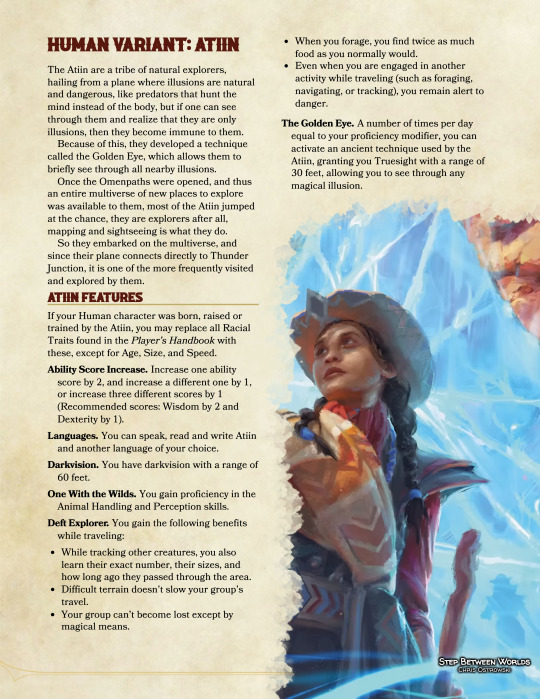
For today's spoiler, the new race, the religious and adventurous Cactusfolk, and the deft Explorers known as the Atiin tribe.
The cactusfolk were animated when the omenpaths were opened to Thunder Junction, while the Atiin have an explorer culture, and when the multiverse opened to them, it was basically a gift from heaven.
Come get Plane Shift: Thunder Junction at my Patreon, its free!
20 notes
·
View notes
Text
I was expecting anything but not Bard
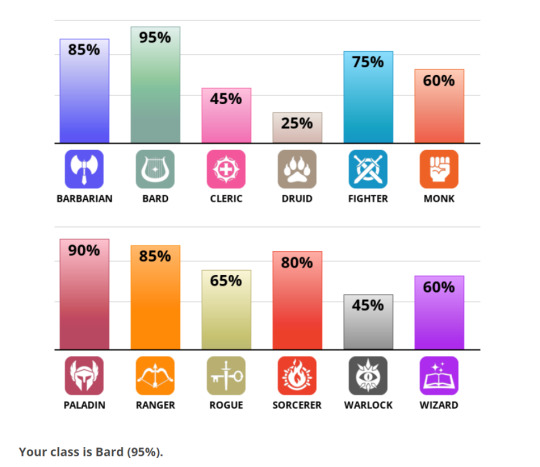
15K notes
·
View notes
Text
As part of breaking DnD’s monopoly on TTRPGs, more media should start basing their knockoff in-universe TTRPGs on different games
124 notes
·
View notes
Text
yeah, and we all know how well balanced SCAG was
anyways, thank you for the feedback! updated version 2.0 here, now with less aggressive Sneak Attack scaling and Carefuler Spell


Subclasseptember Day 1: Barbarian
The Bloodrager - 5E Sorcerer Subclass by Nines
I maintain that "Subtember" still would have been a better title for this challenge.
The first of many entries to the Subclasseptember challenge by @nite0304, the Bloodrager Sorcerer does away with elegance to strike with brutal strength and unyielding focus. A concept from 3.5e, repurposed into a gish option for sorcerer.
As for why I'm making a Sorcerer subclass on the day labelled Barbarian? It simply tickled my fancy to have offclass options for all of these class-based prompts.
Links in the reblogs... Eventually? I'll probably want to have DNDBeyond links to all the subclasses for this challenge in one place at the end of it all.
208 notes
·
View notes
Text



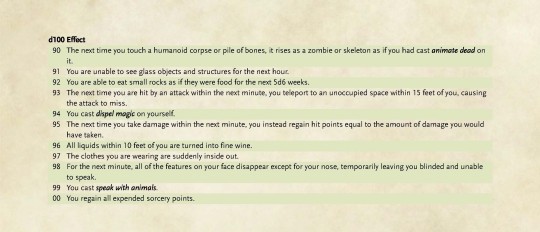
WILD MAGIC SORCERER: RELOADED
I've always had issues with wild magic. Surges are dependent on your GM remembering they exist, and some effects can wipe your party instantly, or bring in summons the GM just needs to have on hand. Outside the funny table, there's not much flavor to the class.
My rewrite puts more of a focus on gambling, more wild effects with less dangerous results, and more wild features.
87 notes
·
View notes
Text
Well this is certainly something (affectionate).
Worth noting: Warlocks don't automatically learn spells from their patron's spell list! They're just added to the list of spells that you can learn, so if the spell's already on the Warlock list (like Crown of Madness) it. Just doesnt do anything.
1st level feature has solid utility, and is kinda comparable to Samurai Fighter combatwise with advantage on an attack multiple times per short rest. It does kinda force you to spec into Eldritch Blast, since you can't exactly get a Hexblade dip for Cha weapons (at least by current 5e rules).
Being able to make a Cha check as part of an attack/spell is kinda weird when you can't actually do anything with it, mechanically. Very subject to DM fiat, at least until 6th level where you also get the ability to charm the target. But Charm Person breaks if you attack the target or its allies, so that seems like it'd be finicky.
Sidenote, does "charm the target as per the Charm Person spell" mean the target gets to roll the save? Does it require concentration? It might be better to simply give it a fixed duration, like "until the start of your next turn" - there are other subclasses like Swashbuckler Rogue that can charm targets without a spell. Stealing the same rules text could be helpful.
Speaking of which, actually, defining an actual roll for the Cha check in the 1st level feature the same way Swashbuckler does could help reduce the amount of DM fiat necessary for that feature as well. That way the player doesn't need to say "hey DM does this effect sound reasonable" every turn, which would be smoother for both the player and the DM.
Sidenote, having one use of the feature for each of an attack roll/saving throw/skill check is unorthodox, but I applaud the creativity. Might be difficult to keep track of, though.
The Hellsite feature... Is certainly aptly named. How powerful it is almost doesn't even matter with how many things you need to keep track of.
The capstone is fun, though the amount of choices you have is somewhat undercut by being forced to rotate through all of them. "Oh, we're going to the Undead Graveyard, you could just walk past all of them!" "Sorry, I used Sans half a week ago so it won't be online for another 3 days." Maybe having it roll randomly?... Then again, that means you'll almost never be able to line it up with what you need. Alternatively, have it be that you can't choose the same one twice in a row? Makes it more likely people will just flip between two that they like, but otherwise gets most of the best of both worlds (a measure of chaos + a measure of control)
Tumblr Sexyman Warlock
15 notes
·
View notes
Text
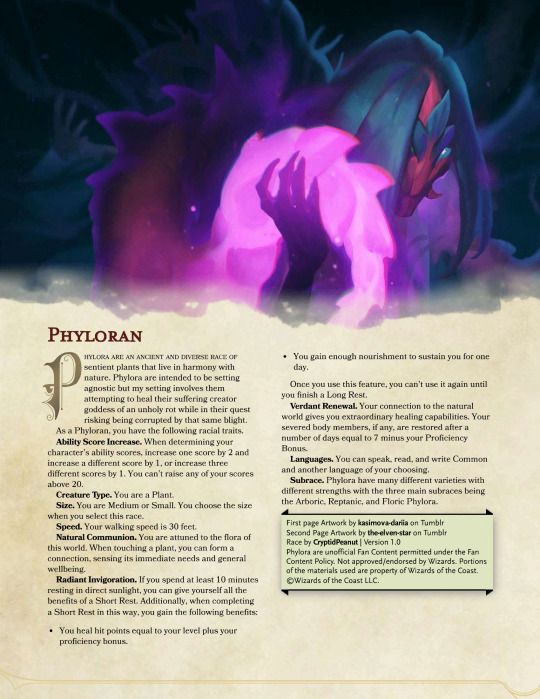

Here's V2! As soon as I posted this on reddit, an embarrassing amount of errors and typos got pointed out. I apologize, I haven't done any 5e writing in a while and I'm still getting back into the groove. Please use this version!
8 notes
·
View notes
Text
What are some chronic illnesses that can only occur in a fantasy setting?
9K notes
·
View notes
Text
DM: Time to get out the Monster Manual, or as some people like to call it: the Waifu Catalogue.
Me: WHAT.
32K notes
·
View notes
Note
The DMG has general guidance for spell creation, but only for raw damage numbers. Obviously, spells with secondary effects are going to deal less damage than equivalently levelled spells without secondary effects (for instance, Scorching Ray vs Ray of Sickness)
Spells with significant, society-altering effects, like Revivify or Create Food and Water, are generally going to be 3rd level even if they lack utility for an adventuring party, mostly for worldbuilding reasons.
There are of course outliers - Goodberry is almost as good as Create Food and Water on a societal standpoint for a much lower spell level, Fireball is purposely overtuned for its spell level - but those tips along with dungeonsandkobolds' pointers are generally a good place to start.
Do you have any advice for making homebrew spells an appropriate power level? I have a really cool idea I'd like to develop but I have no idea what spell level it should be and what exactly its effects should be
The best place to start tbh is to look at similar spells and figure out where it fits within them
Some things to think about with homebrewing spells:
Components - if it's a really good spell, effects a lot of people, or doesn't require concentration generally you'll need to think about Verbal or cost-based Material components, as these help put limits on it. Material obviously limits based on cost, but Verbal components are generally easy to counteract
Does it require concentration? This is especially a good limit to put on things that have long lasting effects on a group of people, or something where you're taking hold over someone
Range - generally I think the better the spell is for the level, the more danger a caster has to put themself in. For instance Bestow Curse can be a really powerful spell that changes the entire battle, but it's range it touch
Spell attack or DC - this one really depends on the effect the spell causes. Spell attack is more like a weapon attack, whereas spells that use DC tend to have a more general effect. The damage of spells that use spell attack also tends to be higher, because if they miss they do no damage at all
Damage - this one I personally tend to find the easiest, because you can ascertain from spells of a similar level what an appropriate amount of damage would be.
Damage dice - this an be chosen based on what is appropriate to the effect of the spell. For instance, Cloud of Daggers uses multiple d4 because there's multiple knives slashing and opponent whereas Spiritual Weapon (at a base level) uses 1d8 because it's a single ethereal weapon attack
What effect would this have in game/on the battle field? Spells that gain more allies/last longer/alter the layout of the fight tend to need more limits place on them. This is also the point to think about, does this spell have the potential to get annoying for a reasonable DM or players
Is there a reasonable way to counteract the spell? This is very important in my opinion, because the ability DnD offers to find creative ways to counteract spells encourages player creativity. It also offers a way for players to be less frustrated if the spell is cast on them, as there's still scope for them to do something about it
Hopefully this helps! I'm sure my wonderful followers will also have more suggestions
14 notes
·
View notes
Text
Alright, let’s start with discourse, shall we?
Gatekeeping Combat
Three days ago, the Gorgon Bones blog made this post about fighters in TTRPGs (particularly the OSR): https://gorgonbones.blogspot.com/2024/02/choosing-fighter-means-choosing-violence.html?m=1
I recommend reading the post, it’s fun (and the comments are hilarious). But, for those who don’t have the time or attention span (trust me, I’m lacking in spoons right now too), this is a relatively short joke that suggests protecting the Fighter class’ niche by making it the only class able to participate in combat. This, on its face, seems like an inherently silly idea—because it is—but people have been interacting with it as a serious suggestion. This comedic concept has spawned a legitimately interesting design discussion. So, let’s engage with it as a thought experiment. How would one make this function in a fun and reasonable way? The simple answer is that you have to start with conflict.
Conflict in RPGs, particularly in Dragon Game derivatives (such as the OSR), is often violent in nature. This presents the first hurdle: How do we centralize combat to 1 class when it’s a major source of conflict, conflict that people inherently want to engage in? As I see it, there are two approaches:
Decentralize Combat.
Redefine “Engaging in Combat.”
Decentralizing combat is kinda just what it says on the tin; make combat a less important source of conflict and means of resolving it. The two biggest examples of this—to me—are Investigative Horror Games and Stealth Games, both of which rely on central conceits that CAN involve violence but don’t necessarily rely upon it. A non-OSR example would be John Harper’s Blades in The Dark, in which combat is resolved the exact same way as every other conflict: through a series of dice rolls that result in ticking and unticking a clock (with possible complications).
Redefining what it means to “engage” requires a bit more definition than the prior approach. “Redefining” can be subcategorized into two somewhat disparate techniques: Redefining goals and redefining interactions.
In any TTRPG combat, the party tends to have a list of goals that exist in a hierarchy of priority. For example, in a traditional D&D or Lancer combat the hierarchy of party goals might look like this:
The Contest (express martial superiority, wipe out the opposition, or otherwise win the combat)
The End State (survive the combat and prevent as much harm to yourself or other party members as possible)
The Barrier (achieve the exploration or narrative goal that’s being hindered or prevented by the combat)
“Redefining” these goals is more accurately described as a re-ordering of their hierarchy based upon whether you are or aren’t the Fighter, usually through gameplay incentives. An incredible example exists in the form of Mike Pondsmith’s Cyberpunk 2020, in which the Solo role (through virtue of acting first and being generally able to specialize heavily into combat) can almost singlehandedly decide the outcome of any fight in which they are present. If there is one Solo on the field, their side is probably going to receive a swift victory; your job, as the non-Solo, is simply to not die and accomplish what you actually came here to do. If there are two Solos on opposing sides of the combat, their goals change to winning their private fight; your job, as the non-Solo, is to survive the surrounding combat until the Solo is free again (or to run if they lose). In almost every combat, the Solo will prioritize the Contest while the rest of the party will prioritize either the End State or the Barrier, something aided by Cyberpunk’s lethality and its nature as a heist game.
“Redefining combat interaction” is . . . actually found everywhere. This is your basic class differentiation taken to a greater extreme than you may find in most tactical RPGs. For example, let’s look at the Combat relevant difference between the Thief/Rogue/Mercenary and the Fighter in a majority of games that use such classes:
The Fighter - Deals a lot of damage with consistently accurate attacks (sometimes also makes multiple attacks on their turn). Has high health.
The Thief - Deals a lot of damage with one really powerful attack made from stealth, sneaky (sometimes good at dodging). Has low health.
The differentiation is there, but it’s not really significant (for the purposes of this thought experiment). Both classes focus on damage output, but one makes multiple attacks and one makes a strong attack that requires setup. Let’s try to take this difference and expand it (with a little help from our dear friend Tolkien), particularly by focusing on what makes the Thief unique in comparison to the Fighter:
The Fighter - Deals a lot of damage with consistently accurate attacks (sometimes also makes multiple attacks on their turn). Has high health.
The Thief - Subverts direct combat through the use of trickery and cunning, plays support for the Fighter (sometimes good at dodging). Has low health.
“Subversion,” in this context, simply means fighting dirty. The Thief shouldn’t be engaging in a head-on fight, they’re a Thief. Their interaction with hostile entities should always be tinged by deceit, their goal should always be to throw their enemy off balance, to create openings for others and themselves to use. If your Thief isn’t constantly throwing pocket sand and disarming opponents and knocking chandeliers on top of them and pulling cloaks over their eyes and poisoning them and . . . are they really living out the Thief fantasy? By strengthening the Thief’s core identity, leaning fully into the trickster aspect, we have redefined how both classes interact with Combat in such a way that has made direct, head-on-head violence the apparent specialty of the Fighter.
Conclusion
As much as the original Gorgon Bones blog post is a joke, Jenx does point out a real issue that’s plagued class-based games for a while: a weak niche makes a weak class. Not necessarily mechanically weak (although that can also happen, looking at you CP2020 Cop), but weak in the sense of fundamental design. Strong niches, even if every class has the ability to participate in combat, are born of purposefully and carefully built interactions with the conflicts presented by a game’s rules and environment. If combat is too great of a focus, everyone is going to want to be able to play the guy who’s good at combat; if winning combat is the sole goal of any given encounter, everyone’s going to play the guy that’s good at winning combats; if every class gets good tools for dealing damage . . . well, I don’t really have to spell that one out, do I?
If you’re designing a tactical, class based game: don’t make the Fighter the only class able to engage in combats. It’s lazy, it’s silly, and it won’t be fun for very long. You may notice that, while the two games mentioned here have classes that EXCEL at direct combat, neither of them fully limit it. Instead, the proper lesson of this thought experiment is a far more common one in our field: keep in mind the incentives you’re building into both your game and your classes, and be aware of how all these moving parts interact with and affect each other. After all, the Solo wouldn’t be nearly as good if Cyberpunk wasn’t so lethal, and the Cutter would be far more ubiquitous if Blades in The Dark had a dedicated combat chapter.
Self Promo
Hey! Thanks for reading. Sorry to leave ya with Baby’s First Game Design Lesson, but I hope ya enjoyed the journey there. If you’d like to see my recent attempt at a class based fantasy game, you can click here to check out Hollow Halls. Otherwise, I hope y’all have a great night and a great day!
79 notes
·
View notes
Text
Ah, the "blow things up with magic" martial! I tried my hand at that idea, but I just ended up recycling it into Swordmage.
The Conduit

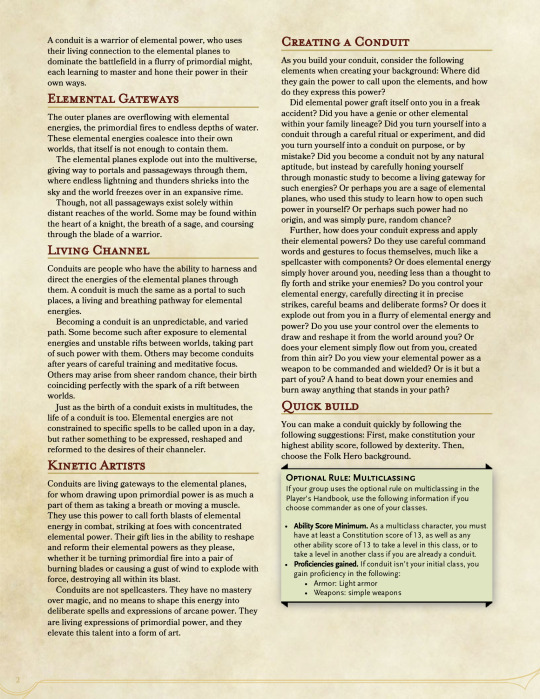
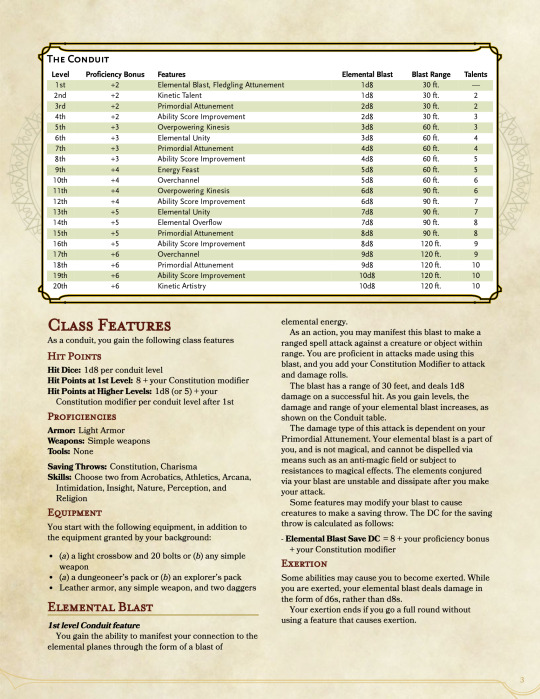
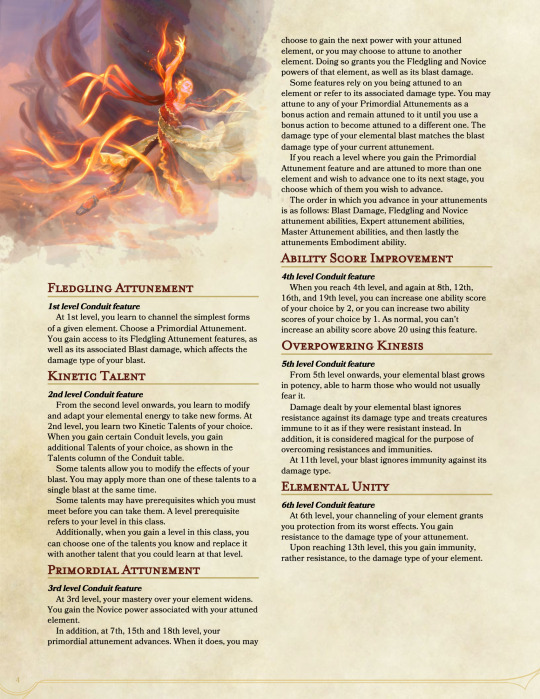

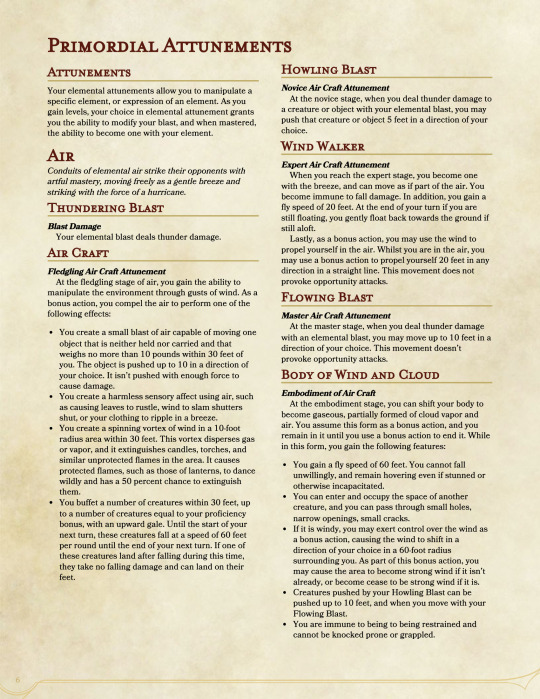



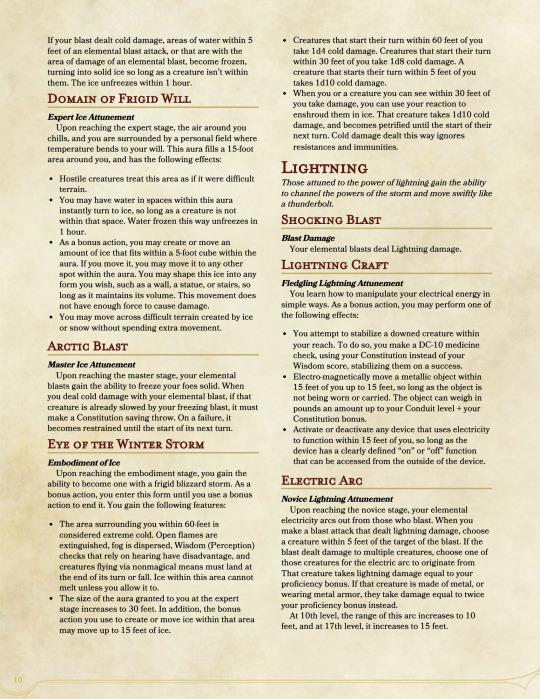
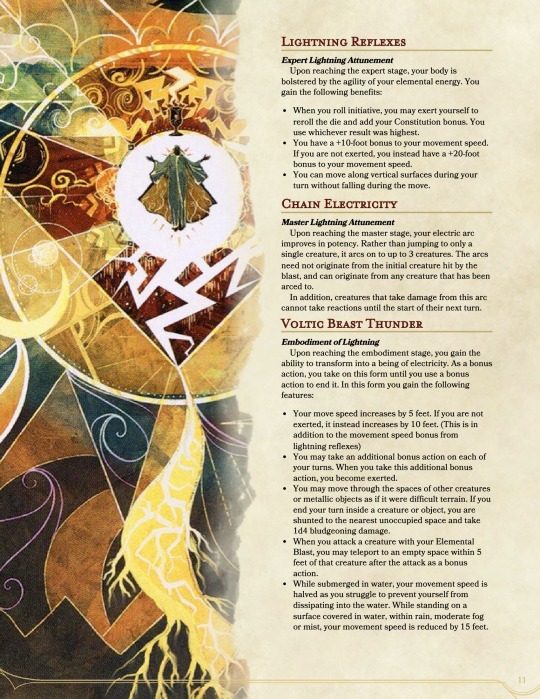
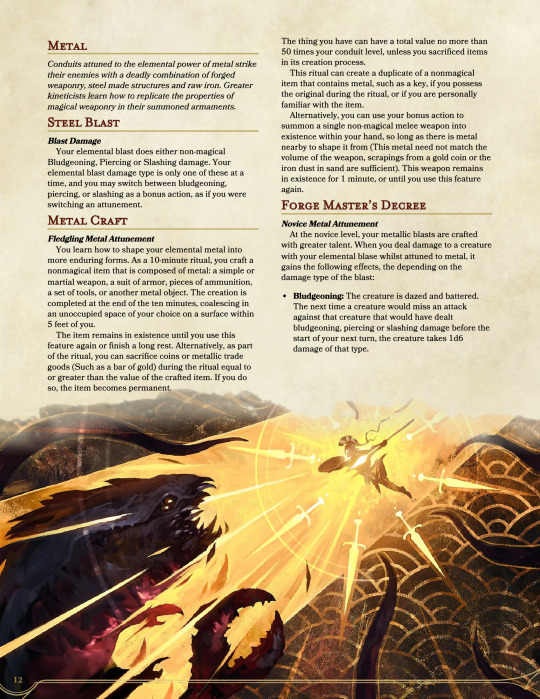
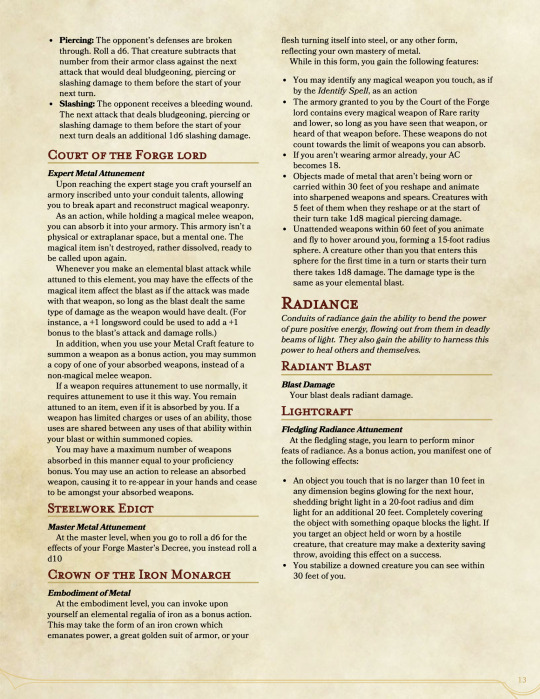

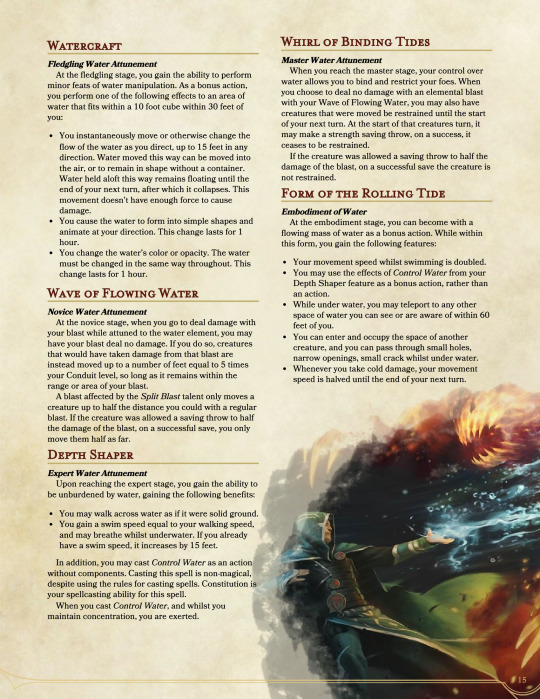
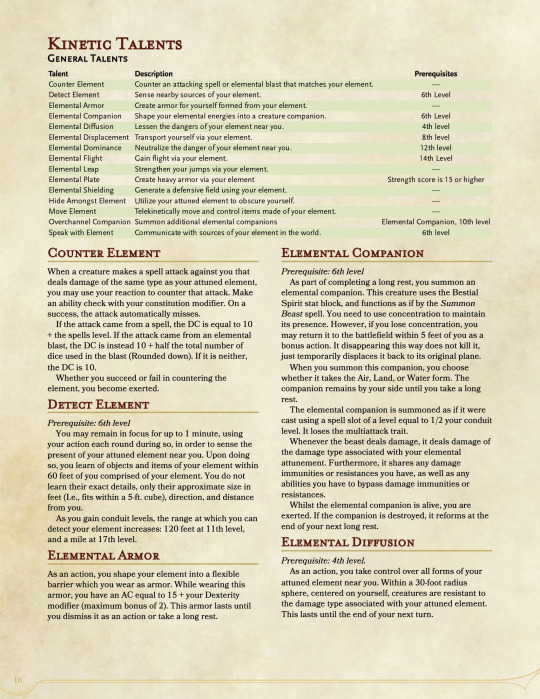

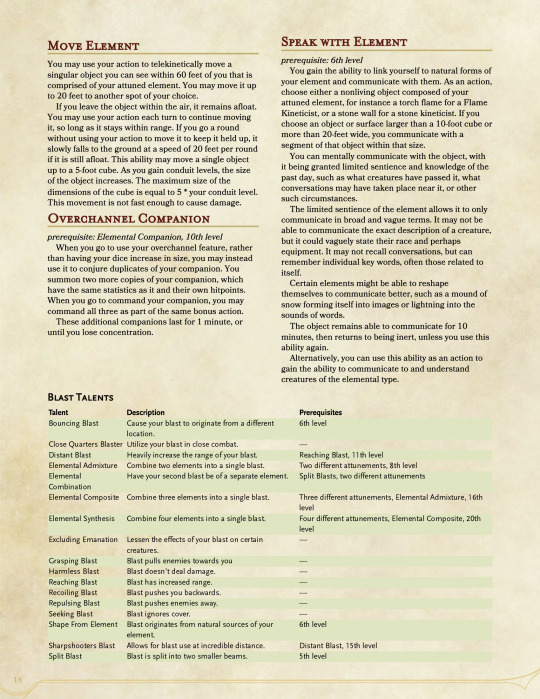
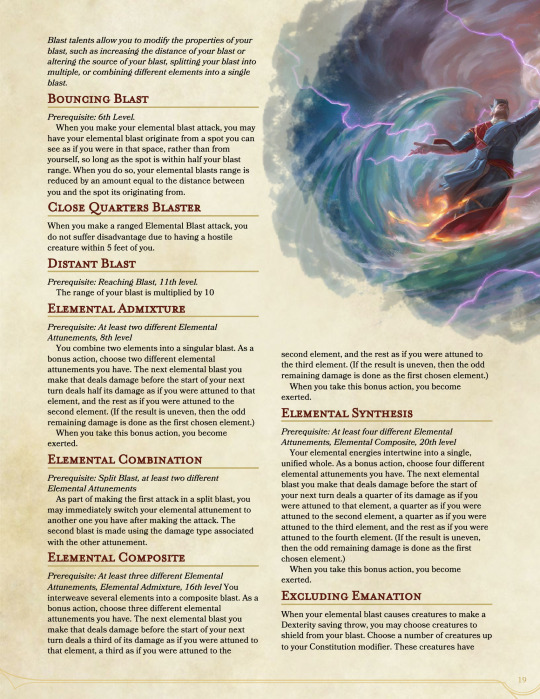
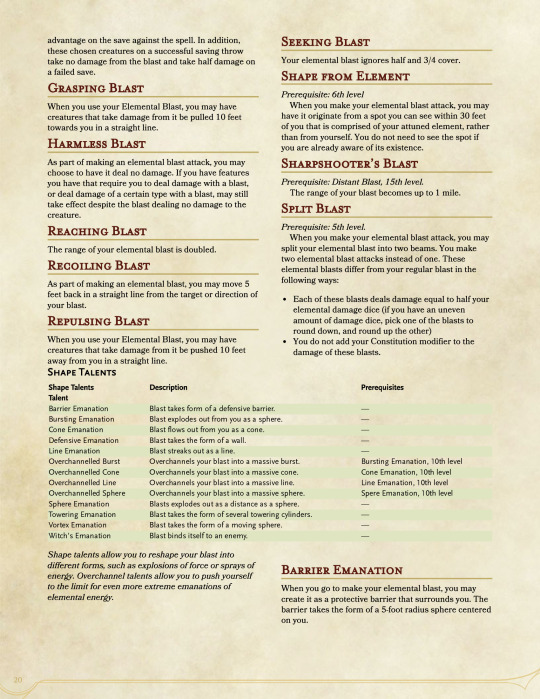


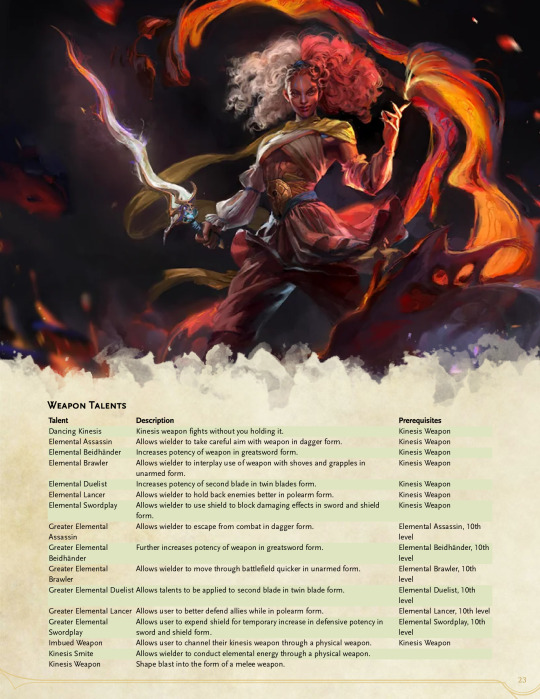

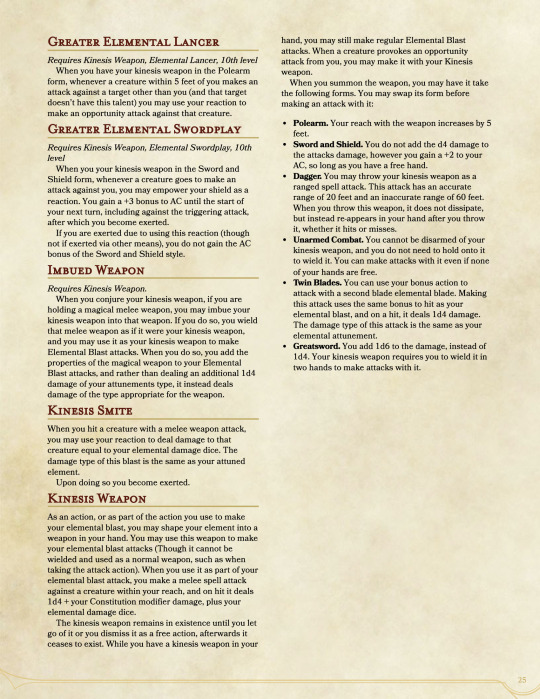

So heres the conduit! I'm very happy with how this turned out.
The conduit as a class is best described as a "Con Based Martial with spellcaster aesthetics", since, mechanically, it fills a martial role, being a class that doesnt use resources, with a primary party focus on dealing damage, while flavor wise, it goes around slinging blasts of energy at people.
This class mechanically is very much based on the warlock of 3rd edition, with flavour and some mechanical inspiration from the Kineticist of Pathfinder 2e.
The two core design elements that I tried to stick to with making this were 1. Being resourceless and 2. Customizability.
For the first point, none of the class features are limited in uses per day. No feature adds an additional resource for the player to track, nor uses spell slots nor etc. The closest it comes to a resource is its Exertion mechanic, where certain things tire out your conduit character. Though, this serves less as a resource, and more as a temporary debuff, reducing your damage output whilst its in effect, before being easily removed.
The second point is customizability. The first element of this is subclasses. Of course, theres the variety of subclasses to pick from, but notably, is that unlike other classes, you aren't bound to picking just one subclass. From 7th level onwards, whenever you reach your subclass feature level, you can choose to continue advancing in your subclass, or you can take the initial features of a different subclass. This means while you can do a more traditional route of going "I'm the lightning guy, I'm taking lightning every level", you can also do an avatar style "Master of 4 elements" and have 4 different subclasses by level 20. Mix and match them as you like, be the "Fire and Lightning" person, be the "I control water mostly, but also a little bit of ice", combine your elements and so forth.
The next part of customizability is in talents. Talents are very much your classic invocation style feature, of which there are... like. 60 of them at this point. But! Theres a lot of variety in what they do. While you have your choices of ones that give additional powers, like flight or teleportation or whatnot, a large bulk of them are dedicated to one thing: Reshaping your elemental blast. Go out there as a fire guy and blast people with fire, then turn around and literally explode everything around you in flames, then focus your blast into a roaring line of fire that pushes everything within it towards you, and then rush the last man standing with a spear made of literal fire.
The talents are designed around not just being able to reshape and modify your blast in a bunch of different ways, but you can combine them together and do cool stuff.
Because at its core, I wanted to design this class to fill a very specific style of fantasy, and thats of the type of magic you see in some settings where its just "I control this one element", and then from that the mage turns that into a billion different things.
A fire wizard will say "I can cast fire bolt, fire ball, and scorching ray". A fire conduit instead just has an elemental blast, but they can turn that elemental blast into a bolt that is hurled at one person, or have it explode into a ball of flame, or split it into multiple beams.
Its very much a creativity first subclass, and thats whats behind its capstone! The capstone is all of this at its epitomy, the ability to freely reshape your elemental power (By freely, temporarily learning talents) into whatever form you imagine.
Hell, customizability is built even into the very core of its flavo
Yeah <3
I hope you guys enjoyed reading this class as much as I enjoyed writing it and as much as I enjoy talking about it <3
103 notes
·
View notes